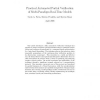Free Online Productivity Tools
i2Speak
i2Symbol
i2OCR
iTex2Img
iWeb2Print
iWeb2Shot
i2Type
iPdf2Split
iPdf2Merge
i2Bopomofo
i2Arabic
i2Style
i2Image
i2PDF
iLatex2Rtf
Sci2ools
CORR
2008
Springer
2008
Springer
Practical Automated Partial Verification of Multi-Paradigm Real-Time Models
This article introduces a fully automated verification technique that permits to analyze real-time systems described using a continuous notion of time and a mixture of operational (i.e., automata-based) and descriptive (i.e., logic-based) formalisms. The technique relies on the reduction, under reasonable assumptions, of the continuous-time verification problem to its discrete-time counterpart. This reconciles in a viable and effective way the dense/discrete and operational/descriptive dichotomies that are often encountered in practice when it comes to specifying and analyzing complex critical systems. The article investigates the applicability of the technique through a significant example centered on a communication protocol. More precisely, concurrent runs of the protocol are formalized by parallel instances of a Timed Automaton, while the synchronization rules between these instances are specified through Metric Temporal Logic formulas, thus creating a multi-paradigm model. Verifi...
Complex Critical Systems | Continuous-time Verification Problem | CORR 2008 | Education | Verification Technique |
| Added | 09 Dec 2010 |
| Updated | 09 Dec 2010 |
| Type | Journal |
| Year | 2008 |
| Where | CORR |
| Authors | Carlo A. Furia, Matteo Pradella, Matteo Rossi |
Comments (0)

